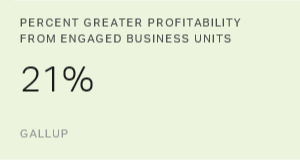Story Highlights
- Without the right culture, your business won't attract star talent
- A winning culture is created by supporting your stars as they grow and develop
In this four-part series, we'll examine the role culture plays in creating a successful organization. First, we discussed how culture affects talent, and this article will explore the elements necessary for successful work cultures. In the upcoming third and fourth articles, we'll examine retention and customer engagement.
High-talent individuals are likely to perform well, even on hard days and in tough situations. That's what makes them exceptional. The first article in this series looked at how culture can be designed to attract the best people -- and how that can improve your organization's future.
For example, Gallup analytics have shown that selecting high-talent managers can lead to 27% higher revenue per employee than average. And selecting naturally talented individual contributors can add 6% higher revenue on top of that. That means you could see 33% higher revenue by creating a culture that attracts star talent.
However, attracting the best people isn't enough. Talented people want to work at places that set them up to succeed.
The kind of culture where great people can thrive has three key elements:
- high engagement
- people in positions that align with their natural talents
- continual opportunities to learn and grow
Cultivate a Culture of Engagement
Engagement is the performance dimension of culture and should be considered part of your culture data dashboard. Engaged employees bring their full selves to their jobs every day. They are excited to be at work and actively look to improve the organization. High engagement has been correlated with nearly every important measure of organizational health -- productivity, retention, safety, customer satisfaction and profit. A highly engaged organization can see 18% higher revenue per employee compared with the average.
Many things people call "company culture" today -- free food in the cafeteria, for example -- are irrelevant to the fundamental psychological needs of employees. Fundamental needs are deeper; things like having a manager who listens, having opportunities for meaningful feedback that lead to personal growth and getting recognition for good work.
Any culture-change strategy should address these basic needs for one important reason: Highly engaged employees respond most positively to change initiatives, which are a constant in today's workplace.
Build a Culture of Strengths
Employees who focus on what they are naturally good at and use their strengths every day are six times more likely to be engaged at work. Sometimes, however, highly qualified people are hired to do what they're best at, only to find out that their real job is something quite different. There are two common reasons:
1. The first is easy to spot: Some organizations have a weakness-based culture. They think they'll see higher performance by focusing on and eliminating their biggest problems. They take pride in harsh performance reviews and being tough on coworkers -- all under the guise of "development." This results in employees spending most of their time trying to avoid mistakes instead of doubling down on what they can naturally do better than almost anyone else.
2. The second reason is less intentional: Good people can get trapped in role creep -- a slow process in which business demands eclipse personal talents. Remember class assignments where one student did 90% of the work and everyone in the group got a good grade? That dynamic can happen in the workplace, too, if leaders let it. Star employees often find themselves doing tasks that are unrelated to their talents, simply to avoid project failure. Sadly, leaders tend to reward this behavior rather than recognize it as a sign of a dysfunctional culture. Eventually, this can lead to burnout, attrition and other negative outcomes.
Organizations in which the two challenges described above occur are missing out on the higher levels of productivity and engagement that come when individuals have the chance to leverage their natural talents. And greater profitability, too -- strengths-based cultures see 8% higher revenue per employee compared with the average.
Design a Culture of Growth
Developing in a role and advancing in a company are especially meaningful steps for millennials, but every worker wants to do well at work and continue to get better over time. In a competitive job market, the best workers have a choice of where they want to work. While they can perform anywhere, they naturally gravitate to those places where they can achieve the most.
External signs of advancement such as more pay or a new title are important. But intrinsic growth -- from key experiences, new knowledge or new skills -- adds value for the employee and the organization in the long run. Organizations need to get creative to help people develop personalized career journeys that allow for new experiences, new relationships, new skills and different kinds of projects.
But most workers don't get the chance. Only four in 10 U.S. employees strongly agree that in the last year they had opportunities to learn and grow at work. If organizations moved that ratio to 8-in-10, Gallup analytics have shown they could realize 44% less absenteeism and 16% higher productivity.
Culture Wins by Helping Employees Win
Cultures that win bring together highly talented individuals and provide them with the support they need to do what they do best, to grow and to develop.
If you combine the additive benefits of talented managers, talented contributors, high engagement and a strengths-based culture, an organization could see 59% higher revenue per employee. This shift could radically transform any organization. And yet, Gallup estimates that less than 1% of organizations have all four of these elements.
But equally important, these aspects should be combined with organization-specific messages, systems, processes and goals that create unique experiences for employees. For example, if you are interested in creating a culture of innovation, then engagement, strengths, and growth should be directed toward processes and outcomes that promote creativity, ideation and risk-taking. High performers may lose interest in generic cultures with no real aim.
But then, so do customers. Cultures built on engagement, strengths and individual growth can live out their mission every day. The purpose of each company is distinct and palpable, like their respective cultures. These are also the kind of organizations that offer unique value to their customers.
Check out Gallup's insights to develop a winning workplace culture:
- Download our report on how to build a culture that drives performance.
- Learn how a strengths-based workplace can help you get the best out of your people.
- Use Gallup-approved surveys to help you understand why star employees stay with or leave your company.


